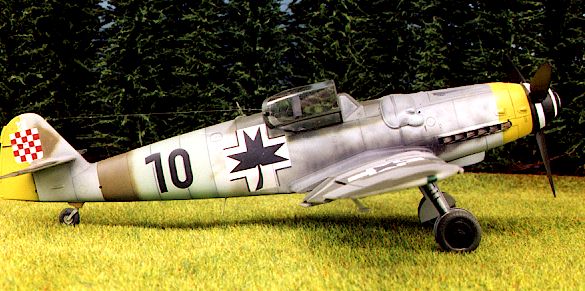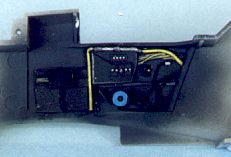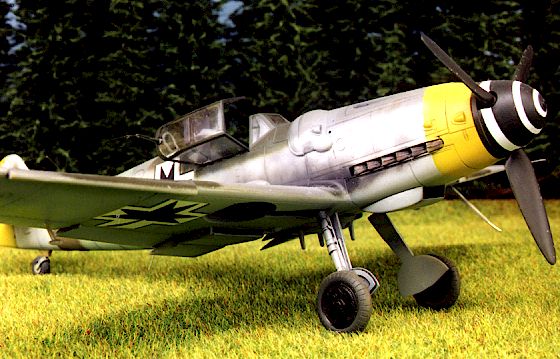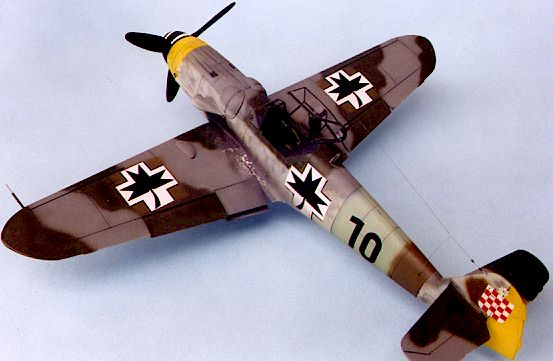Home |
What's New |
Features |
Gallery |
Reviews |
Reference |
Forum |
Search
|
|
Late-War Bf
109s of the Axis Allies
|
|
Bf
109G-14 |
Information is scarce on Croatian use of late-war Bf 109s.
The first part of this new series briefly examines the operations, colours and markings of Croatian Bf 109G-6, G-14 and G-10s during 1944 and 1945. Colours and markings are further examined via a model construction section.
I am very grateful to Denes Bernad for his generous comments and assistance on Part One and also the forthcoming installment on Rumanian use of late-war Bf 109s.
Denes will be publishing a comprehensive history of the Rumanian Air Force in World War Two called "Royal Rumanian Air Force. The Prime Decade (1938-1947)". It will be illustrated by over 150 b/w and colour photos, as well as 30+ colour profiles.
This book will be published in the USA in the summer of 1999.
I will be pleased to hear about any further
information on the camouflage or operations of Bf 109G-6/14/10 in Croatian service.
CONTENTS
Introduction - Axis Allies Use of the Bf 109
Croatian Use
of the Late War Bf 109
Camouflage and
Markings
Building a 1/48 Scale
Croatian Bf 109G-14
Construction
Painting
Conclusion
References
| I n t r o d u c t i o n - A x i s A l l i e s U s e o f t h e B f 1 0 9 |
Over 30,000 Messerschmitt Bf 109s of all types were produced between 1935 and 1945.
The number of Bf 109s employed by Germany's allies was tiny compared to the total number of the Luftwaffe's workhorse fighter in service. However, the supply of Bf 109s was much more than a public gesture on the part of Germany. It was an important strategy in at least three ways:
This series will discuss the use of late-war Bf 109s by Germany's Axis allies. Part One focuses on Croatia.
| C r o a t i a n U s e o f t h e L a t e - W a r B f 1 0 9 |
Background
Croatia was amongst the first Axis allies to operate the Bf 109. Its 109Es were progressively replaced by the Bf 109G-2 from early in 1942.
The Croatian volunteer unit fought beside Germany on the Eastern front under direct Luftwaffe control as a Staffel of an established Jagdgeschwader. 15. (Kroat.)/JG 52 was equipped with Messerschmitt Bf 109Es, then 109Gs. Mounting losses and the harsh conditions on the Eastern Front decimated the number of available Croatian aircraft in the Crimea by February, 1944 to four.
Croatia received a further 20 late Bf 109G6/14s and Bf 109G-10s in 1944/45 for home defence duties. This unit was now re-named the 1st Fighter Squadron. The 2nd and 3rd Squadrons were primarily equipped with Fiat and Macchi fighters.
Croatian Air Force units operated independently on their home soil and in Northern Italy, but under the watchful eye of German officials.

The role of Croatia's late-war Bf 109s was primarily ground support and establishing/maintaining air superiority. The Desert Air Force with its RAF, RAAF and South African Squadrons, and their bases a short hop across the Adriatic Sea in Northern Italy, provided much of the opposition to Croatian 109s. However, Allied air superiority was just one challenge to Croat fighter units. Fuel shortages toward the end of the war were also a chronic problem.
The top-scoring Croat fighter pilot was Nadporucik (Lt.) Cvitan Galic with 38 confirmed air victories. He was killed on the ground by marauding South-African Spitfires at Zaluzani airfield, Croatia, on 6 April, 1944.
Croatian Bf 109 Camouflage and Markings
A couple of defecting Bf 109s in the closing months of the war have provided a valuable insight into the marking of these otherwise elusive Croatian Gustavs. Bf 109G-14 "Black 10" was surrendered at Jesi in Italy on 16 April 1945. The aircraft was flown by Feldwebel (Sgt.) Josip Cekovic who had joined the 2nd Croatian Fighter Squadron in March 1945. Fw. Cekovic had only flown eight missions.
The basic camouflage of this Croatian Bf 109G corresponded to Luftwaffe standards.
Croatian Gustavs were probably finished in a variety of late-war schemes including 74/75/76 Greys, 75 Grey-Violet with 83 Dark Green; and 81 Brown-Violet with 83 Dark Green.
Markings were consistent with southern-theatre markings worn by German and Hungarian fighters during 1944 and 1945. During this period, yellow nose rings and rudders appear to be the norm.
National markings were similar to the mid-war black-and-white Balkenkreuz. The German design was slightly modified to resemble a stylised maple leaf. Markings on the fuselage and upper/lower wing surfaces were all black and white, not the simplified skeleton markings often found on Luftwaffe aircraft at this stage of the war. The location of the fuselage cross on the two surrendered examples is also slightly unusual. It is located two fuselage-stations forward of the standard German position. Both aircraft also have large sections of the mid fuselage overpainted with a colour darker than RLM 76 White-Blue, but much lighter than either of the upper surface camouflage colour. A rear-fuselage band was overpainted in a dark colour.
The Hakenkreuz (swastika) was overpainted with a Croatian shield, topped with a "U" (for Ustazi) in a small diamond.
| B u i l d i n g a C r o a t i a n B f 1 0 9 G - 1 4 |
Hasegawa’s 1/48 scale Bf 109G-14 is the logical choice for this construction project. These Bf 109G-6/14 kits have proven pretty popular on HyperScale to date. This attention is justified - we finally have a kit in 1/48 scale worthy of this significant fighter.
This article will therefore not supply a blow-by-blow construction commentary, but will concentrate on modifications and traps.
Adeco’s Bf 109G Cockpit
Adeco detail sets are mastered by Vincent Kermogant; and produced and distributed by Model Design Construction (MDC). MDC have earned a reputation for their very high quality casting, and this little set reinforces that position.
 Adeco's Bf 109G-6/14 cockpit comprises of replacement
parts for Hasegawa cockpit items. The twelve resin parts include sidewalls, integrated
floor/rear bulkhead/seat, forward firewall with MG 151 breech moulded on, instrument
panel, control column, handwheel mount, REVI gunsight and rudder pedal assemblies. These
delicate parts are in a zip-lock bag and packed in a small, stout cardboard box.
Adeco's Bf 109G-6/14 cockpit comprises of replacement
parts for Hasegawa cockpit items. The twelve resin parts include sidewalls, integrated
floor/rear bulkhead/seat, forward firewall with MG 151 breech moulded on, instrument
panel, control column, handwheel mount, REVI gunsight and rudder pedal assemblies. These
delicate parts are in a zip-lock bag and packed in a small, stout cardboard box.
All parts are moulded in a light grey resin. MDC's casting is exquisite. Detail is as crisp as anything I have ever seen. There are no pinholes or casting flaws on my sample, but one side of my gunsight was softer in detail than the rest of the parts. Cleanup of all parts will be minimal. The cockpit sidewalls are wafer thin. The small casting blocks and connecting flash on these parts will be quickly removed with a new knife blade. Small details are cast onto small pegs that, likewise, will simply require one swipe of a knife.
Research has been thorough. The detail is not only superbly executed, but is also highly accurate. The sidewalls are particularly convincing. Wires, conduits and hoses snake their way around these parts. The subtle but distinctive shape of the pressed metal circuit-breaker panel is well captured on the starboard sidewall. Rudder pedals are very delicate - almost a work of art on their own!
The seat is depicted, in typical Bf 109 fashion, without the backrest. My sample set (MD-A48001) supplies the seat minus the harness, but I understand that another set includes a seat with a moulded-on resin seat belt.
Assembling the Adeco Cockpit
First, the parts should be cleaned up and trimmed. This is a very minor task.
When trimming the port sidewall, start trimming from the top. You’ll need the space at the bottom of this sidewall to correctly position the undercarriage retraction wheel. The front of the port sidewall will need trimming by about 1mm to allow the resin forward firewall to fit behind the step in Hasegawa’s fuselage halves. I also thinned the sides of the firewall to improve the fit.
 As suggested in Adeco’s instructions, glue both
resin sidewalls to the fuselage halves - remembering to leave a gap in front of the angled
fuselage step to allow for the cockpit rear wall. Dry fit the cockpit floor and forward
firewall. Trim the bottom of each sidewall until the top of the seat is at the same level
as the cockpit opening.
As suggested in Adeco’s instructions, glue both
resin sidewalls to the fuselage halves - remembering to leave a gap in front of the angled
fuselage step to allow for the cockpit rear wall. Dry fit the cockpit floor and forward
firewall. Trim the bottom of each sidewall until the top of the seat is at the same level
as the cockpit opening.
Now the small parts can be fitted. I added lead-foil straps to the beautiful rudder pedals, and an Airwaves harness to the seat. Clear acetate was used for the gunsight, and a drop of epoxy glue over silver paint depicted the reflector. The various sub-assemblies were painted before joining the fuselage halves and securing the instrument panel, cockpit floor and firewall.
 Super-glue or two-part epoxy may be used to secure the
Adeco parts. For this project I used epoxy, and I was very pleased with the results. Epoxy
provides plenty of time to reposition parts, while achieving a more robust bond than
superglue can provide. This is especially useful for more delicate items such as the
acetate reflectors and the resin gunsights. I also used epoxy on small plastic kit parts
including mass balances, Morane antenna, canopy armoured glass and the canopy antenna
mast.
Super-glue or two-part epoxy may be used to secure the
Adeco parts. For this project I used epoxy, and I was very pleased with the results. Epoxy
provides plenty of time to reposition parts, while achieving a more robust bond than
superglue can provide. This is especially useful for more delicate items such as the
acetate reflectors and the resin gunsights. I also used epoxy on small plastic kit parts
including mass balances, Morane antenna, canopy armoured glass and the canopy antenna
mast.
Hasegawa’s Bf 109G-14 - In the Box
One might expect that Hasegawa would use almost all of their old "F" and "G-2" kit parts in delivering the G-14. In fact, Hasegawa have seized the opportunity to significantly rework these earlier kits to create a more accurate and better engineered Gustav.
The fuselage is totally new. It features a reinforced nose and smaller gun-trough insert. This strengthens the fuselage and hence minimises fit problems. The supercharger intake is new too. The old version had a big connector pin just behind the intake lip. The new parts do not - there’s a clear view to the fuselage side.
Hasegawa have not sacrificed quality in favour of flexibility. Unlike the Hobbycraft and Fujimi offerings, Hasegawa’s G-14 features a tall-tail moulded as part of the fuselage - no separate pieces and panel-line joins here!

A choice of either standard framed or Erla Haube clear vision canopy is provided. There are even alternate windscreens with either two intake scoops or one scoop and a flare chute. The modeller can also pick one of two versions of horizontal stabilisers, pressed or insert style gun troughs, G-5 or G-6 style starboard breech cover bulge and a new, one piece tailwheel with cover to replace the undernourished item in the earlier G-2 kit.
Roy Sutherland of Cooper Details has pointed out the only serious accuracy problem with this kit. The fuselage is four scale inches short. This would not be a noticeable problem if the four inches was not missing in one small area - between the front of the windscreen and the back of the engine cowling! Fixing the problem would be a very major project, but the rest of the model is just so good...
Another minor compromise in the engineering of the kit is the separate wheel-well "bulges" for the top of the wings. These bulges cause a couple of headaches. First, and most obvious, is the "stepped" effect that the separate parts create. The bulges should "blend" into the wing. A little time with some putty and a sanding stick will fix this problem. Secondly, there is no evidence of the bulged recess when the wheel well is observed from underneath - except for the two locating pins protruding through the flat top wing! Addressing this issue will require a Dremel tool, a round-headed burr, a steady hand and a brave heart.
| C o n s t r u c t i o n |
Not much to add to previous comments on HyperScale about building this kit - it was a sheer joy. Here is a short list of hints to make construction even smoother:
Construction Tips

Additions and Modifications
Hasegawa's Bf 109 was built almost out-of-the-box, with the following exceptions:
| P a i n t i n g t h e C r o a t i a n B f 1 0 9 |
The paint job started by pre-shading black along panel lines. I then painted the yellow rudder with Gunze Acrylic RLM 04 Yellow (H413), followed by a wide swathe of Tamiya Sky circling the mid-rear fuselage.
This band of paint probably overpainted old markings, but why such a big area? If the aircraft wore standard German markings, these could easily have been adapted to the Croatian "leaf design". Is it possible that this aircraft carried different markings when delivered to Croatian forces - such as the square-shaped Hungarian national markings? The square-shaped overpainting of wing markings would seem to support this possibility.

Reference photos show that this colour is darker than RLM 76 White-Blue but slightly lighter than RLM 75 Grey-Violet. A broad range of possibilities exist for this colour - it could be old stocks of 65 Blue, 77 primer or a mix of other colours. I settled on Tamiya Sky as a representation of one of the late-war German Sky Green mixes.
Gunze Acrylic paints were used for the main camouflage colours. This was one of the first occasions that I used their new RLM 76 (H417) and RLM 83 (H423), and I was quite pleased with the results.
Decals were sourced from Aeromaster but, as Murphy's Law would have it, Hasegawa have now released a version of the G-14 kit with these markings!
| C o n c l u s i o n |
The Hasegawa kit was a pleasure to build and has a real air of authenticity about it. The Adeco cockpit was the crowning glory. The Croatian markings combined with German-style late-war southern-theatre paint job are certainly striking.
| R e f e r e n c e s |
"Air War Italy 1944-45" by Nick Beale, Ferdinando D'Amico and Gabriele
Valentini
Published by Airlife Publishing Limited, ISBN 1 85310 252 0
Wings of Fame Volume 11, "Messerschmitt Bf 109: the later variants" by David Donald pp. 46-109
Email correspondence with Denes Bernad, September 1998.
Model, Photos and Text Copyright © 1998 by Brett Green
Page created 11 December 1998
Last updated 09 May 2002
Back to HyperScale Main Page
Back to The Reference Library